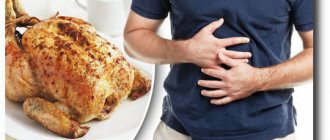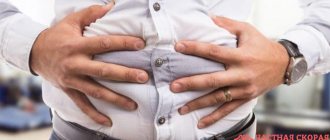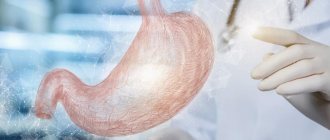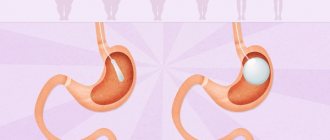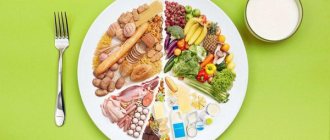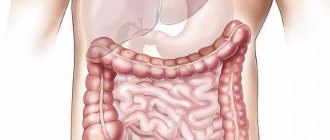The stomach and the processes occurring in it
The stomach can change its shape depending on the amount of food consumed.
When empty, the volume of the stomach is approximately 0.5 liters, with a length of 18-20 cm. The walls, back and front, are shifted, almost touching each other. As the stomach fills, it expands to one and a half liters. The walls are moved to a distance of 8-10 cm from each other. This is within normal limits.
In case of overeating, the stomach can expand to a volume of 3 liters. There are known cases of stretching up to 4l. The size of this organ depends on the height and build of a person, on his nutritional culture, that is, on how, what, and how much food he consumes daily.
Despite its apparent simplicity, the stomach is a rather complex organ, the walls of which contain numerous and varied glands, endocrine cells involved in the work of the whole organism. The gastric mucosa produces gastric juice, which saturates food coming from outside and performs the first stage of its breakdown into various components. During the day, up to 2 liters of gastric juice are produced. An important place in this process is occupied by hydrochloric acid, a chemical active substance. Hydrochloric acid performs the following functions in the body:
- interacts with protein, breaking it down into components,
- destroys harmful organisms that enter the stomach along with food,
- Converts ferrous iron to ferric iron, which is necessary for the formation of blood.
Gastric juice also produces enzymes involved in the breakdown of proteins and fats, and mucus, which lines the walls of the stomach and protects it from the aggressive environment of HCl. Mucus produced during digestion also protects the stomach from self-digestion. Gastric juice begins to be produced before eating. This is facilitated by the smell of food, its appearance, and thoughts about food. Equally important is the time corresponding to the time of eating. This is why it is also so important that a person always eats at the same time.
The production of gastric juice contributes to the appearance of appetite, that is, the need for food.
Organ size in adults and children
The volume and size of the stomach depend on the age of the person. This is due to the characteristics of the body’s growth and nutrition. For example, after birth, children have a very small stomach - its volume does not exceed 7 ml, and its length is 9 cm. This is due to the fact that during intrauterine development the organ does not work, since the child receives all the necessary substances pass through the placenta through the bloodstream. After birth, the size of the stomach increases rapidly. At the age of 8 years, its size is almost equal to the size of the organ in an adult, and its volume reaches 500 ml .
In an adult
The size of the stomach in an adult is constantly changing depending on food intake and other conditions. Normally, the length of the organ is 24-26 cm, the distance between the lesser and greater curvature is 10-12 cm, the anterior and posterior walls are located at a distance of 8-9 cm from each other. On an empty stomach, the stomach is 18-20 cm long, and its walls are practically touch. The volume of an empty organ is 500 ml, after a meal – 1 liter. The maximum capacity of the stomach is up to 4 liters. A similar volume is detected in people with frequent overeating.
Also, the size and volume of the stomach depend on the amount of gastric juice. Women produce from 70 to 80 ml of juice, and men up to 100 ml with each meal, therefore, in males, the volume of the organ is larger.
In a newborn
The size of the stomach on the first day of a child’s life does not exceed the size of a cherry or gooseberry. After one week, the organ grows to the size of a plum; after a month from birth, the organ acquires the size of a chicken egg.
In newborns up to 1 month, the stomach is located horizontally and has a rounded shape. The sphincter of the inlet of the stomach is poorly developed - this explains frequent regurgitation. After birth, the volume of the organ in a newborn is 7 ml, but as a result of rapid growth and adaptation to food intake, it gradually increases. At the age of 1 month, the stomach holds 100 ml, at 3 months - 150 ml, by six months - 200 ml and at 1 year the volume grows to 250 ml. By the end of the first year, the organ acquires an elongated shape and begins to take an oblique position in the abdominal cavity.
From 2 years and older
Upon reaching 2 years of age, the volume of the stomach increases to 350-400 ml. By the age of 5, the volume of the organ approaches that of an adult - 500 ml. Starting from the 8th year of life, the size of the stomach does not increase, however, when overeating, it can stretch up to 1-2 liters. The location of the organ also gradually becomes similar to that of an adult.
What should an adult eat?
An adult's diet should include proteins, fats, and carbohydrates.
For normal functioning of an adult body, it must receive daily:
- Water. The human body is 80 percent water. Water is life. It is found in the tissues and cells of our body, in the blood; water helps remove toxins from the body. Water should be drunk not only in tea, coffee or juices. The body must receive clean, preferably unboiled water.
- Proteins are a source of material that serves to build body cells. Proteins are of plant and animal origin. They are found in meat, eggs, dairy products, legumes and grains.
- Fats are a source of concentrated energy. They can remain in the body for a long time in the form of fat deposits. Sources of fats are vegetable oils, lard, animal fat, and butter. And some high-fat dairy products.
- Carbohydrates are a source of energy that is immediately consumed by the body. True, if a person leads a sedentary lifestyle or consumes them in increased quantities, carbohydrates can also be converted into fat deposits.
- Antioxidant vitamins, nicotinic and other acids are necessary for the body to function normally and are found in almost all foods, especially in vegetables and fruits.
Microelements are involved in the construction of bones, hair structure, and other tissues, in the formation of blood and nerve cells. They are found in all products.
How to shrink your stomach and lose weight
To reduce the size of your stomach, you can reduce the amount of food you eat.
In order for all the above components to enter the stomach, the diet must be varied. The daily menu may include various cereals, soups, pasta, borscht, stewed vegetables, fresh vegetable salads, meat, fish, etc.
Read: Where is the stomach: location, structure and functions in the body
The question is - how much? Each person decides for himself individually. Someone eats a lot, does not gain weight, and does not suffer from it. Some people eat little and don’t lose weight. Much depends on individual vital activity, on the energy consumption of a particular organism.
But let's return to the stomach. How much can it hold? As practice shows, up to 3 liters. But is it necessary to overload it like that? Let's calculate how much the average Russian eats for lunch. A plate of borscht or soup – 300 grams. Another 250 grams will be the second, 100 grams - bread. 650-700 grams is half the stomach full. And that's enough. This is the norm that doctors constantly repeat. Traditional healers echo them, persuading us not to overeat. Compote, jelly or cocoa, that is, the third, you can drink about two hours later, as an afternoon snack.
Most nutritionists believe that breakfast should be hearty. What does tight mean? Should I eat more? Organize your breakfast according to the principle: less is more. In other words, make your breakfast energy-rich. Let the food be smaller in volume so as not to waste extra energy carrying a heaviness in the stomach. But energetic. A difficult working day lies ahead. You need concentration and physical strength. A buttered bun with a banana on top wouldn't hurt here; or a cake, a piece of chocolate or a chocolate candy.
It's great if you have walnuts in your diet. This is a charge for the whole day. Do you like salads? Please. But only from sweet fruits and sour cream. Save your diet cabbage salads for the evening. So in the morning you will eat no more than 350 grams (counting tea or coffee), and recharge your energy. By the way, hot drinks in the morning help the body warm up and invigorate.
Snacks are not forbidden, but this does not mean that you have to run to the refrigerator every half hour. Have one snack between breakfast and lunch. And one - between lunch and dinner.
This can be a saucer of vinaigrette or a nutritious salad, but not more than 100 grams. Between lunch and dinner, the snack should be light in calories. Fruits, a glass of juice, vegetable salad. And for dinner, it is advisable to reduce proteins, fats and carbohydrates to a minimum. Let it be salads and fruit juices with light bran bread. And also no more than 300 grams. Help your body get ready for the coming sleep.
Read: Anatomy: where is the human stomach located, what functions does it perform?
The vicious circle of overeating
Constant overeating leads to an enlarged stomach and food addiction.
Dense and plentiful food that overwhelms the stomach leads to difficulty breathing, the enlarged stomach puts pressure on the lungs, on the heart, resulting in rapid heartbeat, shortness of breath, and fatigue. From below, the stomach compresses the liver, a stabbing pain appears in the side, puts pressure on the hematopoietic organ - the spleen, the blood begins to move more slowly through the veins, and the person becomes sleepy.
If a person does not work, then it is quite natural for him to try to take a nap after a hearty lunch. The energy received along with fats and carbohydrates is not consumed, but is stored in fat. As a result of regular overeating, the muscle tissue of the stomach stretches and stops contracting, the stomach enlarges and requires more and more food, the person gains weight and becomes fat.
He finds himself in a vicious circle: the more he eats, the more his stomach stretches, the more food he requires. The more he eats, the less he moves, and the more fat he gets, the more he wants to eat. And sleep. People who have retired or office workers who lead a sedentary lifestyle usually fall into this vicious circle. Sometimes stress leads to this condition. A person must break this vicious circle himself.
Where to begin? You need to start by taking a beaker or a 200 gram glass. Count how much you eat at one time. This can be done simply by pouring water into the container with which you eat. The water will show you how much food your plate can hold. Have your measurements shown that you eat much more than what is written above? And now it seems to you that by consuming only the specified amount of food, you will die of hunger?
The volume of the stomach also depends on the age of the person.
Start reducing your portions gradually. 30-50 grams daily. Keep a diary and write down for yourself how much and what you ate. Secondly, stop sleeping after lunch. Do you want to sleep? Look around, there’s probably something waiting in the house, waiting for you to clean, repair, and put it in order. Are you a wonderful host and everything is fine with you? Amazing. Go out and take a walk. A half-hour walk will discourage the desire to sleep.
Read: Where is the stomach: location, structure and functions in the body
If you are not working, try to find something to do: working on a plot of land, carpentry, cars - this is for men. Keep yourself busy with something - it will help you use your energy productively and take your mind off the refrigerator. And it may even bring in some money, at least for gifts for grandchildren. Practice shows that increasing physical activity and working in the house even for 2 hours allows you to burn up to 5 kg. in Week.
Electrical appliances have greatly simplified our lives. We stopped doing laundry, washing dishes, and cleaning the floor. All this is done by smart machines. On the one hand, this is good. But it's good for a really busy, working woman. People began to move less. And man was created for movement, for creation. And it’s good when he has a favorite activity for which smart machines free him. But often this does not happen, and food becomes a hobby.
Read along with this article:
- Why does the size of an adult’s stomach vary from person to person?
- What are proteins and amino acids, and what are the dangers of excess proteins?
- What foods contain collagen? How to eat for health benefits?
- Foods containing large amounts of protein: benefits for the body
- What causes stomach cancer and how to treat it
- The work of the pancreas, its special role and significance for everything...
- Anatomy: where is the human stomach located, what functions does it perform?
- Products that reduce acidity and other ways to combat...
- Where is the stomach: location, structure and functions in the body
Gastric distension
Mechanical stretching of the stomach is also one of the signals that is read by receptors on its walls and sent to the saturation center in the hypothalamus. This takes about 20 minutes, so those who are losing weight are advised to eat more slowly. This way you can feel full earlier and avoid eating too much.
The volume of the stomach is approximately 200-500 ml, depending on the individual person. The empty stomach of an obese person is no larger than the stomach of a slender person. This is an elastic organ: when food comes in, it stretches. When she leaves him, she shrinks to her normal size. If a lot of food comes in at once, it will stretch very much. But then it will still shrink back. Thus, the maximum volume of the stomach when stretched is about 4 liters. Well, a regular meal increases it to 1.7-2 liters.
Food does not stretch the stomach, mechanically pressing on the walls. Rather, we should talk about relaxing the stomach and increasing its capacity, and the nervous system is responsible for this. The walls of the stomach are muscles that, like any muscle in the body, are controlled by the nervous system. There are many receptors on the walls of the stomach. When food arrives, the tone of the stomach muscles decreases and it reflexively relaxes. If a person eats an unusually large amount at one time, the receptors on the walls of the stomach will quickly react and send a signal to the brain to turn off hunger. The person will experience a feeling of fullness, a feeling that the food is at the level of a goal, even to the point of nausea.
If you start eating huge portions regularly, the stop signal is pushed back, the receptors lose sensitivity and do not send signals of satiety to the hypothalamus, so a person can eat more and does not feel full for longer. Thus, we are talking rather about increasing the capacity of the stomach in each meal, this is the result of a loss of sensitivity of the receptors from their constant stimulation. But as soon as the food leaves the stomach into the intestines, the stomach returns to its original, normal size.


